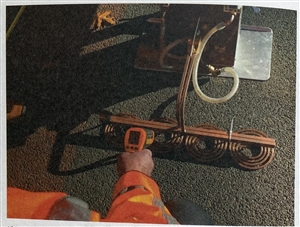Road Pavement Material (Self-Healing Asphalt) Japanese-English Translation Sample
Source: Nikkei Business Publications, Inc., Nikkei Technological Prospects For 2022 - 100 Technologies That Will Change The World
Original Text
自己治癒型のアスファルト舗装
亀裂が入ると埋め込みカプセルが割れ、オイルが染み出て修復
技術成熱度・・・・・・・中
2030期待度・・・・・7.1
ひび割れが生じた際、自ら修復するアスファルト舗装技術の実用が近づいている。
通常のアスファルト混合物に、オイルを入れた直径1.5ミリメートル程度のカプセルと鋼繊維を混ぜておくと、舗装の表層に割れ目が入った際、オイルが染み出て、ひび割れを埋めたり、劣化したアスファルトを軟化させて骨材同士を接着しやすくしたりする。
ひび割れた路面を削り取り、新たな舗装を重ねる補修工事の頻度を減らせ、ニ酸化炭素の排出削減にも寄与すると期待されている。

図 オランダで自己治癒型アスファルト舗装を施工してから5年後に供用状況を確認している様子
舗装表面に特殊機器を当てて加熱するだけで劣化を修復できる
(写真:山田 敏広)
大成ロテックと會澤高圧コンクリートは共同研究中の自己治癒型のアスファルト舗装を2021年度、車両通行の供用を前提とした場所で試験施工する。
自己治癒型のアスファルト舗装はオランダのデルフト工科大学のエリック・シュランゲン教授が開発した。オランダでは高速道路をはじめカ所以上で自己治癒型アスファルト舗装を施工した。
舗装してある程度の時間が経ってからは特殊な機器を舗装の表面に当て強制的に修復させる。アスファルト内に混入したスチールファイバーを温め、こわばったアスファルトを融解させて再び骨材を接着させる。
會澤高圧コンクリートは同技術の独占使用権を持つオランダのべンチャー企業エピオンと2018年にフランチャイズ契約を締結、日本国内での普及を目指して大成ロテックと技術開発を進めてきた。
両社はスチールファイバーを混入した密粒度アスファルト混合物の試体で、繰り返し曲げ疲労試験を実施。一度破壊した供試体を加熱して再度試験機にかけたところ、疲労ひび割れ抵抗性が当初の半分程度までに回復することを確認した。
(真鍋 致彦=日経クロステック・日経コンストラクション)
Translation
Self-Healing Asphalt Pavement
A crevice cracks open the buried capsule, causing oil to flow for a repair.
Technology maturity level: Medium
Expectation for 2030: 7.1
A technology that enables asphalt pavement to repair itself when it is cracked is soon to be available for practical use.
Capsules that contain oil and are about 1.5 mm in diameter and steel fibers are mixed into the regular asphalt mixture. If the pavement surface course is cracked, the oil flows out of the capsules. The main roles of the oil are to fill cracks, and to make the aggregates easier to bond together by softening the degraded asphalt.
The technology is expected to reduce repairs of scraping the cracked road surface and covering the road with new pavement, and to contribute to reduced CO2 emissions.

Figure: Self-healing asphalt pavement in the Netherlands is being checked up for the service conditions in five years after it was constructed.
A simple process consisting of placing a special apparatus on the pavement surface and heating enables recovery from degradation.
(Photo by Toshihiro Yamada)
Taisei Rotec and Aizawa Concrete have a joint research project on self-healing asphalt pavement, and are planning to perform trial construction in the fiscal year 2021 in a location where the pavement is assumed to be subjected to the passage of vehicles.
The self-healing asphalt pavement was developed by Professor Erik Schlangen of Delft University of Technology in the Netherlands. In the Netherlands, the construction of self-healing asphalt pavement took place on more than 20 roads, mainly on expressways.
In a certain amount of time after the pavement, a special apparatus is placed on the surface of the pavement for the forced repair. This raises the temperature of the steel fiber mixed into the asphalt, and melts the hardened asphalt, causing the aggregate to be rebonded.
Aizawa Concrete concluded a franchise agreement with Epion, a Dutch start-up firm which had an exclusive license to use this technology in 2018, and proceeded with technology development in collaboration with Taisei Rotec with the aim of putting it into widespread use in Japan.
They performed repeated bending fatigue tests on specimens of dense-graded asphalt mixture with steel fiber added. During testing, a specimen was destroyed, and then heated, and the heated piece was re-tested with a machine. The results showed that about 50% of the original fatigue cracking resistance was recovered.
(By Masahiko Manabe, Nikkei Construction / Nikkei XTech)